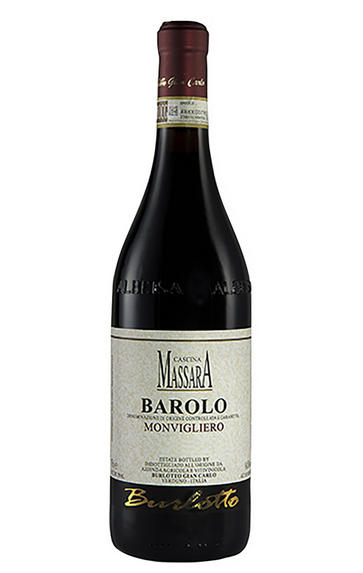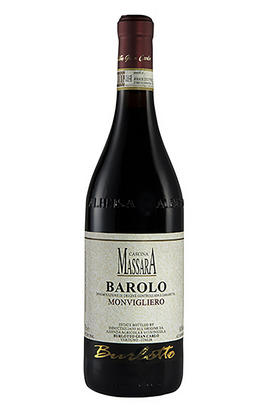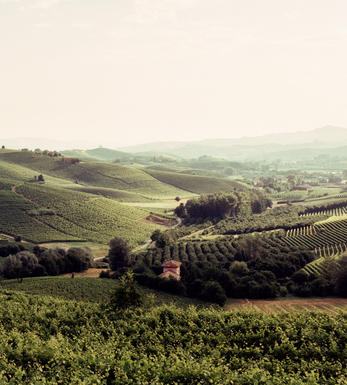
2018 Barolo, Monvigliero, Cascina Massara Burlotto, Piedmont, Italy

Critics reviews
Taking on a bit more spice and ripeness, the 2018 Barolo Monvigliero retains an elegant and refined profile, with pink peppercorn, grenadine, and fresh flowers. It is linear and well-structured, with fine tannins and notes of framboise and wild herbs, and is long with perfume on the finish.
Drink 2024 - 2036
Audrey Frick, JebDunnuck.com (May 2023)
About this WINE

Cascina Massara Burlotto
Cascina Massara, made up of father and son team Giancarlo and Gianluca, is a third of the split Burlotto family. While Giancarlo and Gianluca are much more understated than Castello di Verduno or G.B. Burlotto, they are slowly realising their potential, and have both the expertise and vineyards to match their relatives’ fame.
Their 100% Verduno vineyards span the various altitudes, aspects and soils of the village, and their co-fermented Barolo Classico is testament to this outstanding, varied terroir. Massara is the name of both the family’s Cascina, and their most iconic single vineyard. A rare gem, this old-vine plot yields wines with high-toned aromatics, gripping energy and cool-fruit charisma. It’s unusual in Barolo for a significant vineyard to be owned by such few people, but while the Massara cru is little-known, this will not remain the case for very long.

Barolo
Located due south of Alba and the River Tanaro, Barolo is Piedmont's most famous wine DOCG (Denominazione di Origine Controllata e Garantita), renowned for producing Italy's finest red wines from 100 percent Nebbiolo.
Its red wines were originally sweet, but in 1840 the then extant Italian monarchy, the House of Savoy, ordered them to be altered to a dry style. This project was realised by French oenologist Louis Oudart, whose experience with Pinot Noir had convinced him of Nebbiolo's potential. The Barolo appellation was formalised in 1966 at around 1,700 hectares – only a tenth of the size of Burgundy, but almost three times as big as neighbouring Barbaresco.
Upgraded to DOCG status in 1980, Barolo comprises two distinct soil types: the first is a Tortonian sandy marl that produces a more feminine style of wine and can be found in the villages of Barolo, La Morra, Cherasco, Verduno, Novello, Roddi and parts of Castiglione Falletto. The second is the older Helvetian sandstone clay that bestows the wines with a more muscular style. This can be found in Monforte d'Alba, Serralunga d'Alba, Diano d'Alba, Grinzane Cavour and the other parts of Castiglione Falletto. Made today from the Nebbiolo clones Lampia, Michet and Rosé, Barolo has an exceptional terroir with almost every village perched on its own hill. The climate is continental, with an extended summer and autumn enabling the fickle Nebbiolo to achieve perfect ripeness.
Inspired by the success of modernists such as Elio Altare, there has been pressure in recent years to reduce the ageing requirements for Barolo; this has mostly been driven by new producers to the region, often with no Piedmontese viticultural heritage and armed with their roto-fermenters and barriques, intent on making a fruitier, more modern style of wine.
This modern style arguably appeals more to the important American market and its scribes, but the traditionalists continue to argue in favour of making Barolo in the classic way. They make the wine in a mix of epoxy-lined cement or stainless-steel cuves, followed by extended ageing in 25-hectoliter Slavonian botte (barrels) to gently soften and integrate the tannins. However, even amongst the traditionalists there has been a move, since the mid-1990s, towards using physiologically (rather than polyphenolically) riper fruit, aided by global warming. Both modernist and traditional schools can produce exceptional or disappointing wines.
Recommended traditionalist producers:
Giacomo Borgogno, Giacomo Conterno, Bruno Giacosa, Elio Grasso, Marcarini, Bartolo Mascarello and Giuseppe Mascarello.
Recommended nmdernist producers:
Azelia, Aldo Conterno, Luciano Sandrone, Paolo Scavino and Roberto Voerzio

Nebbiolo
Nebbiolo is the grape behind the Barolo and Barbaresco wines and is hardly ever seen outside the confines of Piedmont. It takes its name from "nebbia" which is Italian for fog, a frequent phenomenon in the region.
A notoriously pernickety grape, it requires sheltered south-facing sites and performs best on the well-drained calcareous marls to the north and south of Alba in the DOCG zones of Barbaresco and Barolo.
Langhe Nebbiolo is effectively the ‘second wine’ of Piedmont’s great Barolo & Barbarescos. This DOC is the only way Langhe producers can declassify their Barolo or Barbaresco fruit or wines to make an early-drinking style. Unlike Nebbiolo d’Alba, Langhe Nebbiolo can be cut with 15% other red indigenous varieties, such as Barbera or Dolcetto.
Nebbiolo flowers early and ripens late, so a long hang time, producing high levels of sugar, acidity and tannins; the challenge being to harvest the fruit with these three elements ripe and in balance. The best Barolos and Barbarescos are perfumed with aromas of tar, rose, mint, chocolate, liquorice and truffles. They age brilliantly and the very best need ten years to show at their best.


Buying options
Add to wishlist
Description
Gianluca’s vines grow in the heart of the legendary Monvigliero site. Less vigorous than those of nearby vineyards, the vines here result in wines of rare mineral pedigree, with floral aromatics and the finest of tannins. This ’18 has a nose of roasted peach, violet, rose and lapsang tea. The palate is firm and serious, with dark berry fruits, herbs, a crystalline crunch and a red-cherry tang.
Drink 2025 - 2038
Davy Żyw, Senior Buyer, Berry Bros. & Rudd
wine at a glance
Delivery and quality guarantee